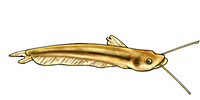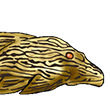This might presumably be useful to aquarists.
Gonçalves, C & C Cestari, 2013. The use of an Atlantic Forest stream by the catfish Scleromystax barbatus (Quoy & Gaimard, 1824). Neotropical Biology and Conservation 8: 115–120.
Abstract
Habitat used by fish is often related with the requirements of the species, according to their morphological characteristics, feeding, and reproductive strategies. We describe the habitat preference, foraging behavior, and camouflage strategy of Scleromystax barbatus (Callichthyidae: Corydoradinae), an endemic catfish from coastal streams in the Atlantic Forest. The movement and foraging behavior of 11 individuals were observed using focal-fish method, and the habitat structure availability (i.e., depth, bottom type, and mesohabitat) was measured in a clearwater stream stretch with 40 m length and 2.8 m width (± 1.5 sd) in southeastern Brazil. In addition, six individuals were captured to verify stomach contents. Habitat selectivity of the species was assessed using the Ivlev electivity index that considers the frequency of occurrence of each habitat variable used by fish in relation to its environmental availability. Scleromystax barbatus selected pools and runs with sandy bottom in depths between 21 cm and 40 cm, and avoided gravel in shallower riffles (up to 10 cm). Individuals foraged close to the bottom in a head-down posture, speculating and revolving the substrate composed by sand, fallen leaves, and twigs. Their long snout and small barbels were used to dislodge the food items of the substrate, which were quickly sucked by the mouth. Aquatic immature insects (mainly trichopterans) were predominant in the stomach contents. Three fish species, Deuterodon iguape Eigenmann, 1907, Mimagoniates microlepis Steindachner, 1877, and Geophagus brasiliensis (Quoy & Gaimard, 1824), were firstly registered following S. barbatus during its foraging activity. The brilliant golden body color with darkish spots of S. barbatus strongly resembles the stream bottom, which indicates disruptive camouflage.
Habitat use in Scleromystax barbatus
- Silurus
- Posts: 12420
- Joined: 31 Dec 2002, 11:35
- I've donated: $12.00!
- My articles: 55
- My images: 893
- My catfish: 1
- My cats species list: 90 (i:1, k:0)
- Spotted: 424
- Location 1: Singapore
- Location 2: Moderator Emeritus





